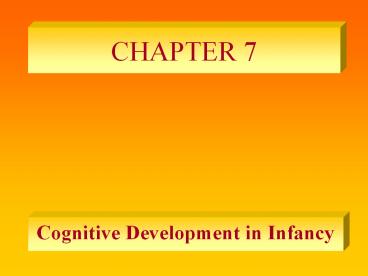Cognitive Development in Infancy PowerPoint PPT Presentation
Title: Cognitive Development in Infancy
1
CHAPTER 7
- Cognitive Development in Infancy
2
PIAGETS THEORY OF INFANT DEVELOPMENTThe Stage
of Sensorimotor Development birth to tow years
progression of infant to organize and
coordinate sensations with physical movements and
actions.
3
Sub-stages Characterized by different schemes
(i.e, sucking, rooting, blinking).
- Germinal period creation of the zygote one
week after conception 100/150 cells. - Embryonic period support systems for cells
2/8 weeks after conception. - Fetal period begins at two months, lasts for
seven period of organ growth.
4
Object Permanence The infant comprehends that
objects continue to exist even when not directly
seen, heard, or touched. Research on object
permanence reveals a wide range of comprehension
by the infant to objects in motion.
5
Evaluating Piagets Sensorimotor Stage Extended
research on his theories has appreciably
increased information regarding them.
- Perceptual development Perceptual abilities are
highly developed early in infancy with
coordination of two sensory modalities seeing
and hearing. - Cognitive development Infants have more
sophisticated perceptual abilities than Piaget
envisioned (i.e., recognizing familiar toys and
seeking them).
6
LEARNING AND REMEMBERING
7
Conditioning classical and operant conditioning
Resulting from research by Pavlov and Skinner
that have far-reaching effects on nurturing.
- Habituation and Dishabituation The infant loses
interest in an action repeatedly presented and
regains interest when a novel aspect is added.
8
Imitation Some researchers believe that infants
in the first days of life are capable of
imitation, while others believe these are merely
automated responses to stimuli.
- Memory Researchers disagree about whether
infants can actually recall information or are
merely responding to implicit researchers agree
the explicit memory occurs in the second half of
the first year.
9
INDIVIDUAL DIFFERENCES IN INTELLIGENCEKnowing
whether the infant is progressing at a normal
rate of development is important but difficult.
Gesells developmental quotient consists of four
categories of behavior motor, language,
adaptive, and personal-social.
- The Bayley Scales of Infant Development assess
infant development along three scales mental,
motor, and behavioral. - The Fagan Test of Infant Intelligence assesses
the infants ability to process information such
as encoding the attributes of objects. - Overall, infant habituation and dishabituation
are important in determining later child
intelligence, in that infants in their first six
months who show greater amounts of attention in
the dishabituation situation reflect more
efficient information processing.
10
EARLY ENVIRONMENTAL INFLUENCES ON INFANT
COGNITIVE DEVELOPMENT
11
Nutrition Although good nutrition provides
optimum physical growth, it can also influence
cognition. Studies of malnourished children find
lower scores on the Bayley test. Other studies
on children given protein supplement indicate
higher cognitive development.
Poverty Children born into poverty are more
susceptible to conditions that will negatively
affect cognitive growth. Intervention programs
that educate parents on enriching practices and
improving quality of life have important positive
effects on cognitive growth.
12
LANGUAGE DEVELOPMENTLanguages have common
characteristics throughout the world they have
generativity, ability to produce meaningful
sentences, and organizational rules.
13
How Language Develops Babies begin linguistic
acquisition through crying, cooing, babbling, and
gestures.
- Recognizing language sounds As language is
composed of phonems, in which certain sound
sequences occur. - First words Usually those related to people and
things in the babys immediate environment. Once
the first word is spoken, a naming explosion
leads to a rapid increase in vocabulary. The
first word usually occurs at 13 months. - Two-word utterances 18 to 24 months rely
heavily on gesture, tone, and context. Toddlers
rely on telegraphic speech, in which short word
utterances convey large meaning. - Language production/comprehension There is a
difference between words that are used and those
that are understood by the child. Their
comprehensive words exceed their productive
vocabulary.
14
Biological Influences Conditions under which
children throughout the world begin to talk
indicates a biological influence. In cultures
where adults do not speak to their infants, the
infants still begin speaking at approximately the
same age as those whose parents speak to them.
15
- Biological evolution Language acquisition by
humans is estimated at 100,000 years old.
Physically adapted to speak, language gives
humans an advantage over other animals. - Brains role in language The speech center of
the brain is considered to be the left frontal
lobe, known as Brocas area, and Wernickes area
in the left hemisphere is believed to be where
comprehension occurs. Studies on brain-injured
patients have revealed a great deal of
information on the brains involvement in speech. - Biological pre-wiring Famed linguist Noam
Chomsky believes humans are equipped with a
language acquisition device that aids the child
to sequence and process phonology, syntax, and
semantics. The uniformity of language
acquisition across cultures supports this finding.
16
Behavioral and Environmental Influences
Behaviorists believe that language is a
responsive action to stimuli in the environment
however, critics argue that the orderliness of
language defies this explanation.
- Children who are not exposed to rich verbal
environments still acquire the grammatical
orderliness of language, but do not develop a
sophisticated level of vocabulary and
articulation. - Maternal influence is a key factor in language
acquisition. - Infant-directed speech is a manner in which
parents speak to their infants that has a higher
pitch with simple words and phrases. - Techniques such as echoing, expanding, and
labeling are natural devices parents use to
encourage speech in their children.

